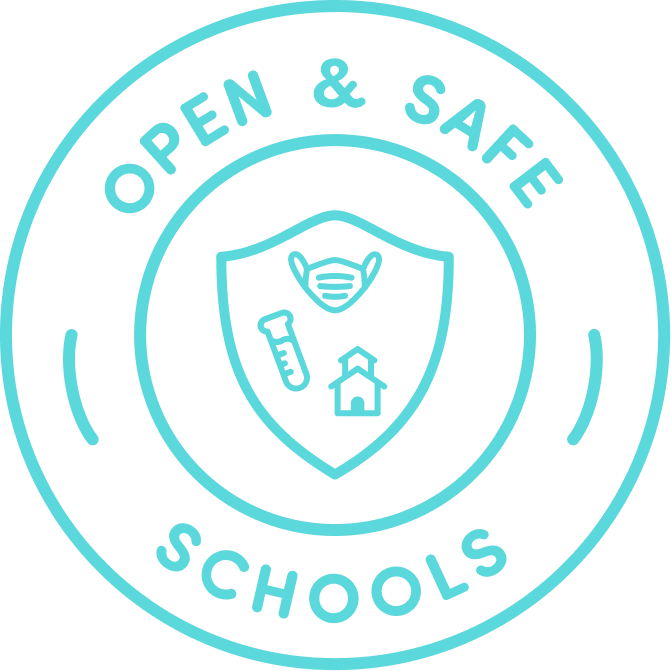Epidemiology Laboratory Capacity (ELC) Reopening Schools
Guidance & Technical Assistance for Funding Recipients
Click to jump to details about…
For Technical Assistance designing your program, please email the ELC Team.
Funding Guidelines
For Jurisdictions
Activity 1
Rapid deployment of screening programs.
Engage with state and local education agencies (SEAs/LEAs).
Support end of school year 2021 and school affiliated summer programs.
Facilitate initial learning to inform school testing plan development.
Activity 2
Development of K-12 screening testing plan.
Finalize key program decision points, including any engagement with testing vendors.
Define how school districts can participate in testing.
Consider legal and regulatory requirements.
Activity 3
Implement screening testing action plan.
Roll out COVID-19 screening testing for the 2021-2022 school year.
Ensure a strong start to school in the fall.
Enable schools to remain open and in-person to the extent possible.
Detect cases and limit ongoing transmission.
Funds can be provided
to schools by:
Contracting with testing companies
Partnering with local or chain pharmacies
Partnering directly with laboratories
Directly contracting with schools
Establishing an account to allow for reimbursement of schools
Coordinating with state department of education to facilitate financial support for schools
Sub-awarding to local health departments to support screening
Supporting IT systems to monitor screening testing in schools
Allowable Expenses:
Personnel
Lab equipment
Collection Supplies, test kits, reagents etc.
PPE
Courier service contracts
Hardware/software necessary
Tools for monitoring and analysis
Contracts with academic institutions, labs, or other health care entities
Software
Leasing / purchasing vehicles
Program incentives may be considered to encourage individuals to participate in screening testing
Wrap around services for those who test positive
Expenses associated with outreach and assistance
Expenses associated with technical assistance to establish school-based screening programs
Model State Program
Below are the components of a model state COVID-19 testing program to guide you in setting up your program. For requirements, please refer to the funding guidelines section above and the detailed program guidance here.
Financing Model
Funding Options
State pays vendors directly (using federal funds) for any school that signs up for the program
State grants or reimburses school districts who implement pre-approved vendors and testing protocols
No cost to students or staff. Testing, including any necessary confirmatory testing, should be provided free of cost to all participating in the program.
Public Vendor List
Negotiated contracts with at least two vendors. Identifying school testing vendors is challenging for individual school districts. A state contract list ensures the program is available equitably to all schools in the jurisdiction and prices are kept low.
Require vendors to supply
School COVID-19 Testing Vendor Implementation Materials.
Access to public contract list and prices for all institutions serving children in the jurisdiction, including independent schools, childcare, after school programs and summer camps.
Transparent data about each vendor option, including: sensitivity and specificity for each test, turnaround time for each vendor, and - for laboratory developed tests - an expert data review.
Options for additional school district support, including vendors to support on-site specimen collection operations, program management, and contact tracing
State should monitor capacity weekly of test kits and central lab capacity on public contract list to identify and solve bottlenecks.
See more details on vendor selection here and see our instructions to vendors on School COVID-19 Testing Vendor Requirements to serve schools here.
Program Structure
Available to all schools, including those that are not yet open for in-person learning.
Weekly / twice-weekly tests available to all staff and students. Use higher frequency for lower sensitivity (e.g., antigen) tests.
Required testing for students participating in high contact sports or other after school activities.
Statewide standing physician order to cover all tests done as a part of the program. Alternative: templates that districts can use to establish district-wide standing physician orders.
Statewide CLIA Certificate of Waiver, with a simple application process that allows schools to be designated as CLIA waived sites. (Click for more information about CLIA Waived Tests)
Statewide consent form for students and for staff, to be customized as needed by individual school districts.
Public Health Guidance
Clear rationale for testing frequency and included populations based on viral spread patterns and test sensitivity and specificity.
Confirmatory tests. Guidance for in which situations confirmatory tests are required.
Quarantine guidance. Who needs to quarantine at each stage in the process, considering operational implications for staff and students, when students can and cannot ride the bus, etc.
Public health reporting. What test results and what information must be reported to public health officials.
Vendor Selection
Step 1: Select Testing Modality
Common school testing strategies are
Point of care antigen tests used twice weekly
Pooled PCR tests used weekly
Individual PCR tests used weekly
A state vendor list may include more than one testing modality, however be sure to include support and guidance for school districts on how to compare and choose between testing modalities.
Step 2: Find and Evaluate Vendors
Schedule calls and ask questions to understand what capabilities each vendor has.
Search the School COVID-19 Testing Partner List, maintained and supported by the Rockefeller Foundation and Health Catalysts Group.
Then use the Testing Partner Questionnaire to ensure you’re asking the right questions to find the right vendors for your state or jurisdiction.
Step 3: Compare All-In Costs
Different testing modalities and different testing vendors come with different costs, some of which are in the contract and others are borne by the individual schools. Use the COVID-19 Response Advisors Budget Planning Tool to compare the all in costs of different testing modalities.




